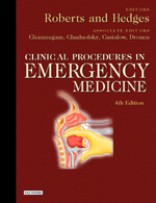|
|
|
| |
 |
|
|

|
 推薦指數:
推薦指數:





|
|
- 內容介紹
|
Clinical Procedures In Emergency Medicine, 4th Edition
James R. Roberts MD, Professor, Emergency Medicine, Department of Emergency Medicine, Director, Division of Toxicology, Allegheny University of the Health Sciences, MCP*Hahnemann School of Medicine, Philadelphia, PA; Chair, Department of Emergency Medicine, Director, Division of Toxicology, Director, Institute for the Treatment of Poisonous Bites and Stings, Mercy Health System, Mercy Hospital of Philadelphia/Mercy Fitzgerald Hospital, Philadelphia,PA
Jerris R. Hedges MD, MS, Professor and Vice Chair, Department of Emergency Medicine, and Director, Emergency Medicine Research Programs, Oregon Health Sciences University, Portland OR; Attending Physician, University Hospital and Veterans Affairs Medical Center Hospital, Portland, OR; Editor-in-Chief, Academic Emergency Medicine
ISBN 0721697607 · Hardback · 1504 Pages · 1400 Illustrations
Saunders · Published December 2003
Completely revised and updated, this new 4th Edition gives detailed, step-by-step instructions and illustrations help to ensure every emergency technique is performed correctly. Each chapter explores the full range of issues surrounding a clinical procedure, including indications and contraindications, equipment, technique, interpretation, complications, and more.
Reviews
"Since the first edition appeared in 1985, Roberts and Hedges has been the final word in procedures...Dedicated to not only the how, but the why, when, and who of performing procedures."
-- The Journal of Emergency Medicine
"If it needs to be done and needs to be done now let this be your guide...The authoritative, annotated, academic standard in its category."
-- JAMA
What's New
Provides new chapters on use of monitoring devices, vagal maneuvers, EKG techniques, procedures during pregnancy, standard precautions and infectious exposure management, and the management, administrative, and educational aspects of clinical procedures.
Offers a new section on teaching procedures to students and trainees
Features 30% new authors, including 4 new associate editors, ensuring a broad perspective
Includes over 500 new illustrations
Contents
Section I: Respiratory Procedures
1. Basic Airway Management and Decision-Making
2. Tracheal Intubation
3. Pharmacologic Adjuncts to Intubation
4. Cricothyrotomy and Translaryngeal Jet Ventilation
5. Tracheostomy Care and Tracheal Suctioning
6. Noninvasive Assessment and support of Oxygenation and Ventilation
7. Mechanical Ventilation
8. Thoracentesis
9. Tube Thoracostomy
Section II: Cardiac Procedures
10. Cardiosinus Massage/Cardioversion
11. Defibrillation
12. Assessment of Implanted Pacemaker/AICD Devices
13. Emergency Tranvenous Cardiac Pacing
14. Emergency Transcutaneous Cardiac Pacing
15. Pericardiocentesis and Intracardiac Injections
16. Artificial Perfusion During Cardiac Arrest
17. Resuscitative Thoracotomy
Section III: Vascular Techniques and Volume Support
18. Pediatric Vascular Access and Blood Sampling
19. Arterial Puncture and Cannulation
20. Peripheral Intravenous Access
21. Guide-Wire (Seldinger) Techniques for Catheter Insertion
22. Venous Cutdown
23. High-Flow Infusion Techniques
24. Central Venous Catheterization and Central Venous Pressure Monitoring
25. Accessing Indwelling Lines
26. Intraosseous Infusion
27. Endotracheal Drug Administration
28. Autotransfusion (Autologous Blood Transfusion)
29. Transfusion Therapy: Blood and Blood Products
30. Pneumatic Antishock Garment
Section IV: Anesthetic and Analgesic Techniques
31. Local and Topical Anesthesia
32. Nerve Blocks of the Thorax and Extremities
33. Regional Anesthesia of the Head and Neck
34. Intravenous Regional Anesthesia
35. Systemic Analgesia and Sedation for Procedures
Section V: Soft Tissue Procedures
36. Principles of Wound Management
37. Methods of Wound Closure
38. Skin Grafting in the Outpatient
39. Soft Tissue Foreign Body Removal
40. Incision and Drainage
41. Burn Care Procedures
Section VI: Gastrointestinal Procedures
42. Esophageal Foreign Bodies
43. Nasogastric and Feeding Tube Placement
44. Balloon Tamponande of Gastroesophageal Varices
45. Decontamination of the Poisoned Patient
46. Peritoneal Procedures
47. Abdominal Hernia Reduction
48. Rectal Procedures
Section VII: Musculoskeletal Procedures
49. Out-of-Hospital Splinting
50. Management of Amputations
51. Extensor Tendon Injuries in the Hand and Wrist
52. Management of Common Dislocations
53. Splinting Techniques
54. Podiatric Procedures
55. Trigger Point Therapy
56. Injection Therapy of Bursitis and Tendonitis
57. Arthrocentesis
58. Compartment Syndrome Evaluation
Section VIII: Genitourinary Procedures
59. Urologic Procedures
Section IX: Obstetric and Gynecologic Procedures
60. Emergency Childbirth
61. Culdocentesis
62. Examination of the Sexual Assault Victim
63. Removal of and Intrauterine Device
Section X: Neurologic Procedures
64. Management of Increased Intracranial Pressure and Intracranial Shunts
65. Spinal Puncture and Cerebrospinal Fluid Examination
66. Special Neurologic Tests
Section XI: Ophthalmologic, Otolaryngologic, and Dental Procedures
67. Ophthalmologic Procedures
68. Otolayngologic Procedures
69. Emergency Dental Procedures
Section XII: Vital Sign Measurement
70. Vital Sign Measurement
Section XIII : Special Procedures
71. Procedures Pertaining to Hypothermia
72. Hyperthermia Procedures
73. The Sedative-Hypnotic Interview
74. Bedside Laboratory and Microbiologic Procedures
75. Universal Precautions
APPENDIX
Commonly Used Formulas and Calculations
|
|
|

